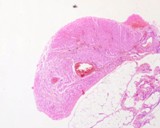Segmental aplasia of paramesonephric duct
The failure of development of a part of the uterus is segmental aplasia, as a segment of the paramesonephric duct fails to develop. The cause of this is not known. A reduced size of one part of the uterus is termed hypoplasia. McIntyre et al (2010) also used the term uterus unicornus when one horn was missing. I consider this segmental aplasia of the entire horn.
One would expect that with a failure to develop, there would not be any tissue present. This is seldom the case. Usually there is mesometrium and a thin thread of tissue where the uterus should be. The tubular genitalia proximal to the aplastic region is usually dilated and has hydrometra or hydrosalpynx (see above).
Histologically, there is usually a thin strip of smooth muscle that is the external smooth muscle layer that is present in the mesometrium. No distinct myometrium and endometrium is present, but in each case I have seen there was mesometrium present.
McEntee (1990) reports seeing 2 cases of bilateral aplasia of the proximal horn of the uterus.
Schulman and Bolton (1997) report seeing 2 cases of unilateral aplasia of the uterine horn. the right horn was affected in each. The distended horn proximal to the aplasia contained mucopurulent exudate and had ruptured in one dog. The other case was an incidental finding at neutering.
Oh et al (2005) report one case of segmental aplasia of the uterine body and marked bilateral dilation and filling of the uterine horns with a thin fluid. There was a single thread like cord of tissue connecting the right uterine horn to the cervix. This cord had an outer layer of smooth muscle and an inner content of blood vessels but no epithelium.
Ortega-Pacheco et al (2006) examined 300 stray bitches and found 1 that had a unilateral segmental aplasia of the uterine horn.
McIntyre et al (2010) reports on a large number of cases from 32,660 dog neuters. 11 dogs had an absence of one horn, 5 left and 6 left. 3 dogs had segmental aplasia of a segment of one horn. 1 had hypoplasia of a horn. Many had ovaries in place despite the segmental aplasias.
Rousset et al (2011) report on case with concurrent segmental aplasia of the ureter. They suggest the primary defect is in the mesonephric duct, but the uterus develops from the paramesonephric duct, and the ureter the metanephric duct. These are derived from a similar location to the mesonephric duct, so a failure of interaction of stroma and peritoneum in this location would be the underlying defect.
Nakamura et al (2012) reports on a single dog with bilateral segmental aplasia of the uterus. The proximal ends were dilated and filled with pus, thus pyometra is present. One distended part of one horn had twisted/torsion.
Mir et al (2013) reporting on finding one that case of uterine stenosis.
There are 4 cases in the YagerBest Histovet database. I have seen many more....
Segmental aplasia of the horn of a uterus. All that remains is a thin strip of tissue that is smooth muscle.
Histology of a bitch with uterine segmental aplasia. The only tissue present is smooth muscle attached to the mesometrium (YB157432).
McEntee K (1990) Reproductive Pathology of Domestic Mammals. Academic Press p 120-121
Mir F, Fontaine E, Albaric O, Greer M, Vannier F, Schlafer DH, Fontbonne A. Findings in uterine biopsies obtained by laparotomy from bitches with unexplained infertility or pregnancy loss: an observational study. Theriogenology. 2013; 79: 312-322.
McIntyre RL, Levy JK, Roberts JF, Reep RL (2010) Developmental uterine anomalies in cats and dogs undergoing elective ovariohysterectomy. J Amer Vet Medl Assoc 2010, 237 (5): 542-546.
Nakamura K, Yamasaki M, Osaki T, Ohta H, Sasaki N, Aoshima K, Kimura T, Takiguchi M. (2012) Bilateral Segmental Aplasia with Unilateral Uterine Horn Torsion in a Pomeranian Bitch. J Am Anim Hosp Assoc 2012, 48: 327-330
Oh K-S, Son CH, Kim B-S, Hwang S-S, Kim Y-J, Park Y-J, Jeong J-H, Jeong C, Park SH, Cho K-O. (2005) Segmental aplasia of uterine body in a adult mixed breed dog. J Vet Diag Invest. 17: 490-492, 2005
Ortega-Pacheco A, Segura-Correa JC, Jimenez-Coello M, Linde Forsberg C. (2006) Reproductive patterns and reproductive pathologies of stray bitches in the tropics. Theriogenology.
Rousset N, Abbondati e, Posch B, Owen LJ, Herrtage M (2011) Unilateral hydronephrosis and hydroureter secondary to ureteric atresia, and uterus unicornis in a young terrier. J Small Animal Pract 2011 52: 441–444.
Schulman ML, Bolton LA. (1997) Uterine horn aplasia with complications in two mixed-breed bitches. J S Afr Vet Assoc. 68(4): 150-153.



